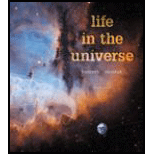
Concept explainers
Is There Life Elsewhere? After considering all the evidence to date about the possibility of extraterrestrial life, do you believe it is likely that we'll find microbial life elsewhere? Do you believe it is likely that we'll find intelligent life elsewhere? Defend your opinions, using arguments based on the full range of scientific issues discussed in this book.
If microbial life is possible elsewhere and chances of intelligent life.
Answer to Problem 1DQ
There is a possibility of existence of microbial life elsewhere due to common elements around universe and also various conditions on earth indicates similar condition in universe making human belief for possibility of microbial life. Intelligent life is also possible in universe.
Explanation of Solution
There is a great possibility of microbial life in universe.
Various evidences for such possibilitiesare as follows:
- The elements that are found on earth are very common in universe and carbon molecules which help in life formation can also be formed easily.
- Life on earth was possible even under harsh conditions which were supposed to be harmful. All these adverse condition made life adaptable to the changes in them with changing condition. These similar conditions are common in all over universe with less variation which makes humans belief that life can exist in universe.
- Earth became habitable after long time of formation of universe. This makes it evitable that there might be other planets too that had life on them.
According to the books it is believed aliens would be much advanced from human civilization. They will be intelligent and more superior. Some books even suggested aliens would come to help and solve problems of human.
Conclusion:
Thus, There is a possibility of existence of microbial life elsewhere due to common elements around universe and also various conditions on earth indicates similar condition in universe making human belief for possibility of microbial life. Intelligent life is also possible in universe.
Want to see more full solutions like this?
Additional Science Textbook Solutions
Applied Physics (11th Edition)
University Physics (14th Edition)
University Physics with Modern Physics (14th Edition)
Essential University Physics: Volume 2 (3rd Edition)
Essential University Physics (3rd Edition)
- What is the difference between chemical evolution and biological evolution?arrow_forwardIf you represent Earths history by a line that is 1 m long, how long a segment would represent the 400 million years since life first moved onto the land? How long a segment would represent the 4-millionyear history of humanoid life?arrow_forwardWhat are the advantages to using radio waves for communication between civilizations that live around different stars? List as many as you can.arrow_forward
- Why are we limited to finding life on planets orbiting other stars to situations where the biosphere has created planet-scale changes?arrow_forwardWhat are the three requirements that scientists believe an environment needs to supply life with in order to be considered habitable?arrow_forwardWhy was the development of photosynthesis a major milestone in the evolution of life?arrow_forward
 Foundations of Astronomy (MindTap Course List)PhysicsISBN:9781337399920Author:Michael A. Seeds, Dana BackmanPublisher:Cengage Learning
Foundations of Astronomy (MindTap Course List)PhysicsISBN:9781337399920Author:Michael A. Seeds, Dana BackmanPublisher:Cengage Learning Stars and Galaxies (MindTap Course List)PhysicsISBN:9781337399944Author:Michael A. SeedsPublisher:Cengage Learning
Stars and Galaxies (MindTap Course List)PhysicsISBN:9781337399944Author:Michael A. SeedsPublisher:Cengage Learning
 AstronomyPhysicsISBN:9781938168284Author:Andrew Fraknoi; David Morrison; Sidney C. WolffPublisher:OpenStax
AstronomyPhysicsISBN:9781938168284Author:Andrew Fraknoi; David Morrison; Sidney C. WolffPublisher:OpenStax



